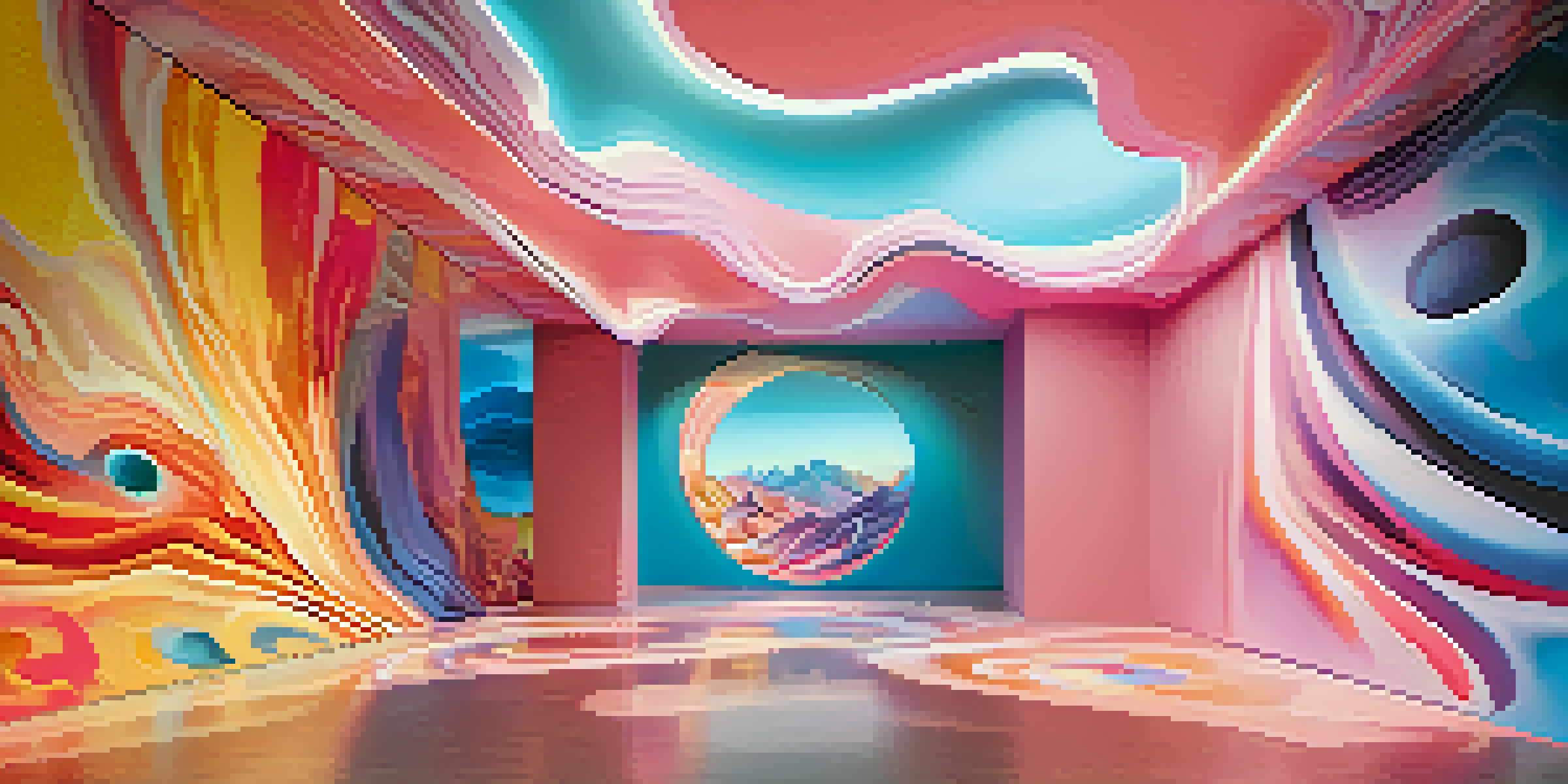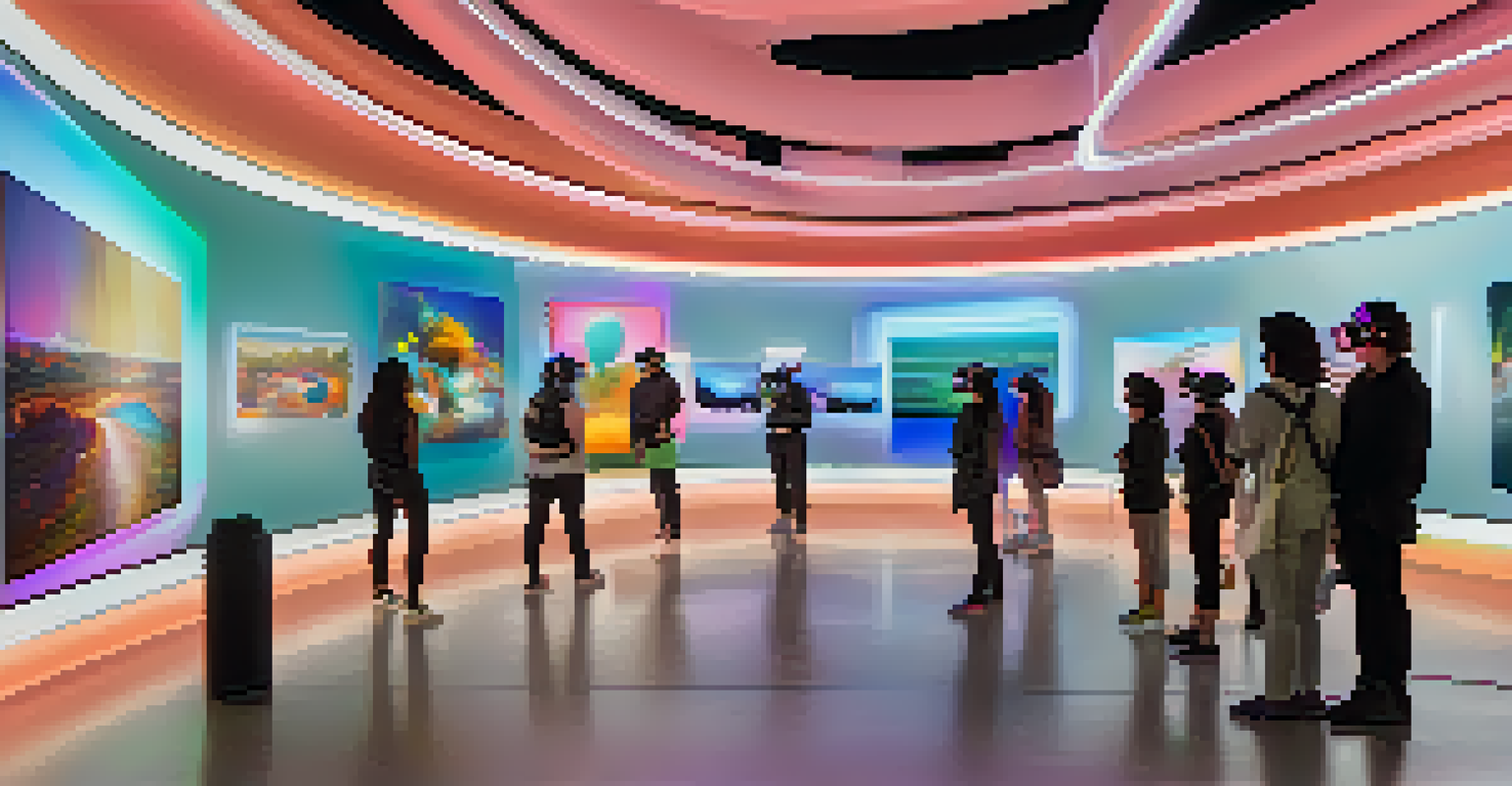Virtual Reality in Art: Redefining Immersive Experiences

Understanding Virtual Reality in the Art Realm
Virtual reality (VR) has emerged as a groundbreaking medium in the art world, allowing artists to create fully immersive experiences. Unlike traditional art forms, VR engages the audience in a three-dimensional space where they can interact with the artwork. This shift enables a deeper emotional connection and a sense of presence that flat images simply can't provide. As technology evolves, VR is becoming a staple in contemporary art, blurring the lines between artist and audience.
Virtual reality is not just a new medium; it’s a new way of thinking about art and the experience of art.
One of the most exciting aspects of VR in art is its ability to transport viewers to entirely new worlds. Imagine stepping into a painting, where colors swirl around you and landscapes shift before your eyes. This level of immersion not only captivates your attention but also invites you to explore and interpret the artwork in ways that were never possible before. It's like stepping into a storybook where you control the narrative.
Related Resource
Artists, too, are finding new avenues for expression through VR. By using this technology, they can create interactive installations that change based on viewer input, turning spectators into participants. This democratization of art encourages collaboration and community engagement, making art more accessible and relevant to diverse audiences.
Notable Examples of VR in Art
Several pioneering artists have embraced virtual reality to create stunning works that challenge traditional boundaries. One notable example is 'Tree,' an immersive experience that allows users to live the life of a tree, witnessing its growth and the changing seasons. This innovative piece highlights environmental issues, allowing participants to feel the impact of climate change firsthand.

Another remarkable project is 'The Night Cafe,' which brings Vincent van Gogh's iconic paintings to life in a virtual setting. Visitors can wander through a 3D recreation of the artist's famous bedroom or enjoy the vibrant colors of his landscapes. This experience not only celebrates van Gogh's genius but also invites audiences to step into his world, fostering a greater appreciation for his artistry.
VR Transforms Art Engagement
Virtual reality immerses audiences in art, allowing them to interact with and influence the experience in meaningful ways.
These examples illustrate how VR can transform the way we experience and interact with art. By creating immersive environments that engage the senses, artists are redefining what it means to appreciate and understand art in a modern context.
The Role of Technology in Artistic Innovation
Advancements in technology play a crucial role in the evolution of virtual reality art. With more affordable VR headsets and user-friendly software, artists from various backgrounds can explore this medium. This accessibility democratizes artistic creation, allowing not just seasoned professionals but also emerging artists to experiment and innovate.
Art is a way of survival. It allows us to express our feelings, and VR takes that expression to a new level by immersing us in a world of our own creation.
Moreover, the integration of augmented reality (AR) with VR is pushing the boundaries even further. AR allows artists to overlay digital elements onto the physical world, creating a hybrid experience that merges reality with imagination. For instance, a mural could come to life through an AR app, revealing hidden layers and animations that enrich the viewer's experience.
Related Resource
As technology continues to advance, we can expect even more thrilling developments in the intersection of art and virtual reality. The potential for interactive installations and multisensory experiences is limitless, paving the way for a new era of artistic expression.
Challenges Faced by VR Artists
Despite its many advantages, creating VR art comes with its own set of challenges. One significant hurdle is the steep learning curve associated with VR software and hardware. Artists who are accustomed to traditional media may find themselves overwhelmed by the technical aspects of VR, which can hinder their creative process.
Additionally, the cost of VR equipment can be prohibitive for many artists, limiting their ability to experiment with this medium. While prices have decreased in recent years, high-quality VR setups still require a significant investment. This financial barrier can restrict the diversity of voices being represented in virtual reality art.
Innovative Artists Embrace VR
Pioneering artists are using VR to create interactive installations that redefine traditional art boundaries and promote community engagement.
Lastly, there is still a degree of skepticism surrounding VR art. Some critics argue that it lacks the authenticity and emotional depth of traditional art forms. As the medium continues to evolve, artists will need to find ways to address these concerns and demonstrate the unique value that VR can bring to the art world.
The Impact of VR Art on Audience Engagement
Virtual reality art has the power to transform audience engagement by making art more interactive and participatory. Unlike passive viewing experiences, VR invites viewers to step into the artwork and become part of the narrative. This shift encourages deeper emotional connections and fosters a sense of ownership over the experience.
For example, VR installations often allow viewers to manipulate their environment or influence the artwork's progression. This level of interactivity empowers audiences to explore their interpretations and form personal connections with the art, leading to a more meaningful experience. It's like being part of a living, breathing artwork that evolves with each viewer's interaction.
Related Resource
As audiences become more accustomed to immersive experiences, their expectations for art will undoubtedly change. This evolution challenges artists to continually innovate and find new ways to captivate and engage audiences, ultimately enriching the cultural landscape.
Future Prospects of VR in the Art World
The future of virtual reality in art is brimming with potential. As technology continues to advance, we can anticipate more sophisticated and immersive experiences that push the boundaries of creativity. Artists will likely experiment with new storytelling techniques, creating narratives that unfold based on viewer choices and interactions.
Furthermore, the integration of artificial intelligence (AI) into VR art could lead to entirely new forms of expression. AI could analyze audience reactions in real-time, adapting the artwork to enhance engagement and emotional impact. This fusion of technology and creativity opens up exciting possibilities for artists and audiences alike.
Challenges in VR Art Creation
Despite its potential, artists face hurdles such as technical complexities, costs of equipment, and skepticism about the medium's authenticity.
As VR becomes more mainstream, we may also see a rise in virtual art galleries and exhibitions, allowing global audiences to experience art from the comfort of their homes. This accessibility could democratize the art world, breaking down geographical barriers and fostering a more inclusive environment for artists and art lovers.
Conclusion: Embracing the VR Art Revolution
In conclusion, virtual reality is reshaping the art world in profound ways, offering new opportunities for creativity and engagement. As artists embrace this technology, they are redefining what it means to experience and interpret art. The immersive nature of VR allows audiences to connect with artwork on a deeper level, creating lasting memories and emotional responses.
While challenges remain, the potential for innovation and exploration in VR art is limitless. As technology evolves, so too will the ways in which we experience and appreciate art, fostering a vibrant and dynamic cultural landscape. It's an exciting time to be both an artist and an art enthusiast, as the boundaries of creativity continue to expand.

Ultimately, embracing the VR art revolution means recognizing the transformative power of technology in the creative process. As we stand on the brink of this new era, we can look forward to a future where art is more immersive, interactive, and inclusive than ever before.